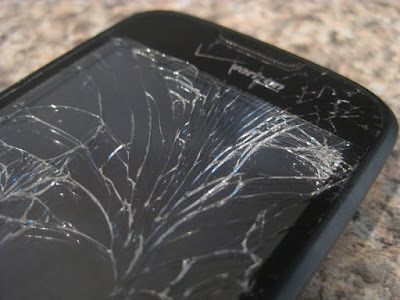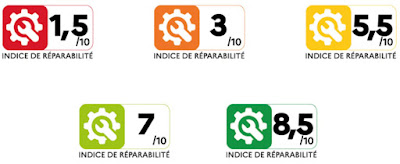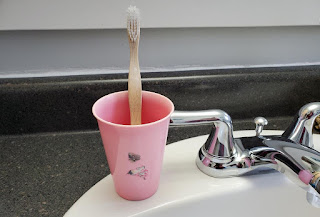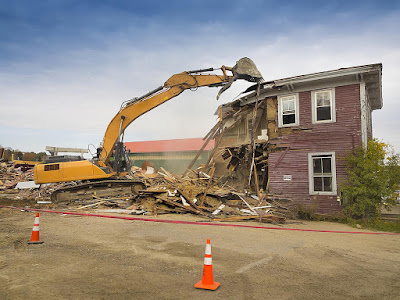Have you noticed in the last few years (decades?) how it's gotten cheaper to buy a new [fill in the blank] rather than repair the old one? Whether it's a fridge, freezer, computer, lamp or bread-maker, somehow repairing these items has gotten ridiculously expensive, while the cost of a new one has gotten relatively cheap. There's something wrong with this picture.
I know that manufacturers have been building things under the motto of "planned obsolescence" for years now. The idea being, manufacture something so that it will only last a few years and the consumer (that's us) will have to buy a new one. Gone are the days when you buy a washing machine and expect to keep it for 25 years. Now, we're lucky if they last 10 years.
Part of this is also the "latest" fad. We need the "latest" iPhone or iPad or smartphone or purse or whatever. And where do the old ones go? The broken and worn out devices that are only a few years old? Well, hopefully they get recycled but... that's not always the case. Apparently a LOT of dead devices are sitting in people's cupboards, not being recycled. Some even end up in the garbage where they leach toxic waste.
 |
| Broken smartphone screen "Droid Eris meets pavement" by robertnelson is licensed under CC BY 2.0 |
It's not an ideal scenario. Can you imagine if we changed cars as quickly as we changed our smartphones? Oh... wait... I think some people do that! But what if you always had to take your car to the dealership to get it repaired? What if independent mechanics couldn't access the user manuals and specs on your car's electronic systems? You'd be paying through the nose for dealership repairs. Sounds ridiculous but up until a few years ago in the USA, that was exactly what was happening. If your car broke down, you'd have to have it towed to the dealership. Their "proprietary" repair manuals and specs were not available to independent mechanics. You, as the car owner, did not enjoy the "Right to Repair". Crazy, yes?
Well... the exact same thing happens today with smartphones and other electronic devices. Oh sure, people can figure it out and there are all sorts of people and businesses that will repair smartphones but... did you ever notice the most appliances have a little phrase on the back/bottom? Something along the lines of "Attempts to open this appliance/case will void the warranty". Imagine if that is written on the undercarriage of your car motor? "Sorry... this car is not repairable... go and buy a new one."
The manufacturers don't make it easy for anyone else to repair their devices. In fact, repairability is not something that dovetails nicely with planned obsolescence. After all, why would you make something easily repairable if your ultimate goal is to have the device break down so that the consumer will buy a new device? The thing is... our current level of consumption is not sustainable. If the entire world consumed items at the same rate that we do in Canada and the USA... we'd need to find five more Earths. Not going to happen. We need to conserve what we have and use it very wisely.
Even something as simple as replacing the battery in a smartphone or a laptop can be a challenge. I remember our first smartphones (Samsung Galaxy S2) ... you could easily remove the back and access the battery and SIM card. Same with my old laptop... just pop out the batter housing and pop in a new one. Not anymore. Our new (1 year old) Samsung Galaxy S10s do not have a removable back. Same with my HP laptop. If the battery starts failing... well, then, it's time to replace the entire laptop and/or phone. There's a website, IFIXIT, that scores the repairability of smartphones... Here's what it has to say about the S10
- battery replacement is possible but still unnecessarily difficult
- glued-down glass both front and back means greater risk of breakage and makes repairs difficult to start
+ a single Phillips driver takes care of all the screws
 |
| Repairability index of a Samsung Galaxy S10 smartphone |
That's just crazy... but that's a lack of repairability for you. The S10 scores only a "3" on the list (out of a possible 10). Does any smartphone score a 10?? Well, our old S2 scored an "8"... hmph. The S5 (which we also had) scored a "5"... And then the S7 scored a "3". See the pattern? Older phones are more repairable than the new ones. Sigh. But... there is hope... enter the FairPhone 3 which scores a solid "10" on the scale of repairability. The Shift 6m (German company) scores a "9". All of the other newer phones (since 2019) score a "6" or lower. The thing is... buying a new smartphone is NOT a cheap endeavour! They usually cost well over $1000 CAN and that is a hefty chunk of change.
This is why repairability is about to explode onto the global market. France is first out of the starting gate by introducing an index of "repairability" for things like washing machines, lawnmowers, televisions and smartphones. The ultimate goal is to reduce the amount of waste and keep appliances and devices in circulation for longer. Nearly two-thirds of Europeans would rather repair their products than buy new ones... savvy people.
 |
| France's repairability index (scale of 1 to 10) |
And... in November 2020, the European Parliament followed suite and voted to support consumers' Right to Repair.
The resolution was adopted with 395 in favour and just 94 against, with 207 abstentions.
“By adopting this report, the European Parliament sent a clear message: harmonised mandatory labelling indicating durability and tackling premature obsolescence at EU level are the way forward,” said Rapporteur David Cormand, MEP from France.
Apparently, more and more US states are proposing Right to Repair legislation in their jurisdictions as well. Which is good news!
There are, however, a few potential hiccups with the French system... manufacturers are the ones who grade their devices/appliances on how repairable they are. Hmmm... still, it's a start and time will tell how that works as people engage with the devices and decide if the repairability index is accurate!
 |
| Repair Café from Wikipedia |
The truth is... some appliances have gotten so complicated (I'm looking at you Smart TV) that it's no longer an easy thing to just replace a tube or a transistor (or whatever). Repairing a Smart TV can be a daunting prospect.
On the other hand... we have also lost a lot of the repair no-how for simple things like a hole in a sock. My Mom used to darn our socks (remember that!?) but I don't think I'd be able to do it. Not only do I not have a darning block/egg, but our entire sewing kit fits in a cookie tin. There's no big supply of yarn or thread. We can still sew buttons back on... but that's about it! So... in some cases, the tendency to not repair isn't due to a lack of repairability... just a lack of ability!
I'm hopeful that this repairability thing will take off... we can do our own part. By not buying the latest whats-it... but taking our broken whats-it to a repair cafe. By asking manufacturers about the repairability of their devices/appliances. It can be hard. Not to be driving the latest flashy SUV. Ours is just a few months shy of it's 25th birthday... imagine that... driving the same vehicle for 25 years. Radical thought.
P.S. Another news article came out which indicates that the repairability legislation is spreading across Europe! Excellent news.

















